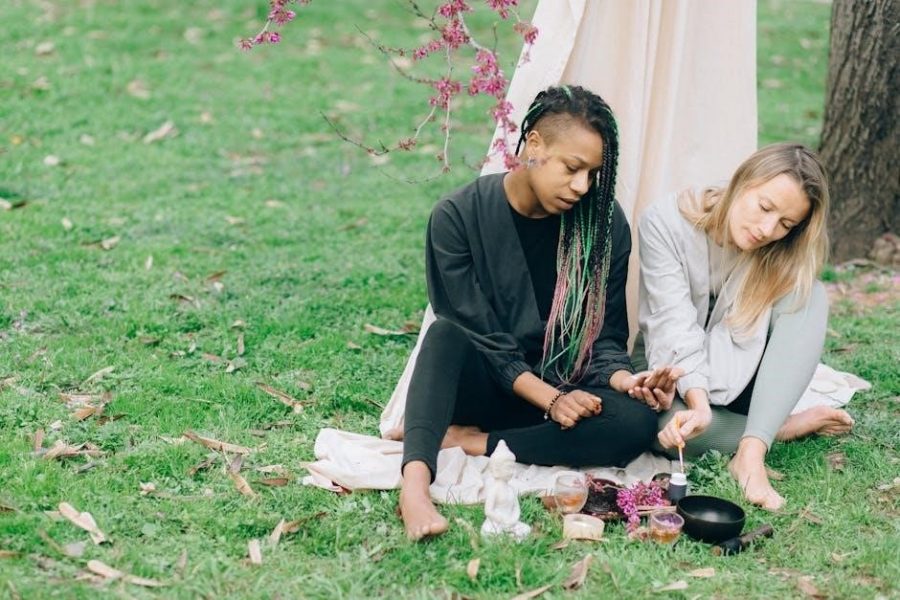Bikram Yoga‚ also known as hot yoga‚ involves 26 specific poses practiced in a heated room. This 90-minute sequence targets the entire body‚ promoting strength‚ flexibility‚ and detoxification. A downloadable PDF guide offers a detailed breakdown of each pose‚ helping practitioners master the technique and enjoy its benefits.
Overview of Bikram Yoga
Bikram Yoga‚ also known as hot yoga‚ is a dynamic practice performed in a heated room with a temperature of around 105°F and 40% humidity. It consists of a 90-minute session featuring a specific sequence of 26 postures and two breathing exercises. These postures are designed to work the entire body‚ promoting strength‚ flexibility‚ and detoxification. The heat is intended to simulate the climate of India‚ where yoga originated‚ and is believed to deepen stretches and cleanse the body through sweating. Bikram Yoga is structured to be accessible to all levels‚ with each pose building on the previous one‚ creating a comprehensive workout. A downloadable PDF guide provides detailed insights into the poses and their benefits‚ making it a valuable resource for practitioners.
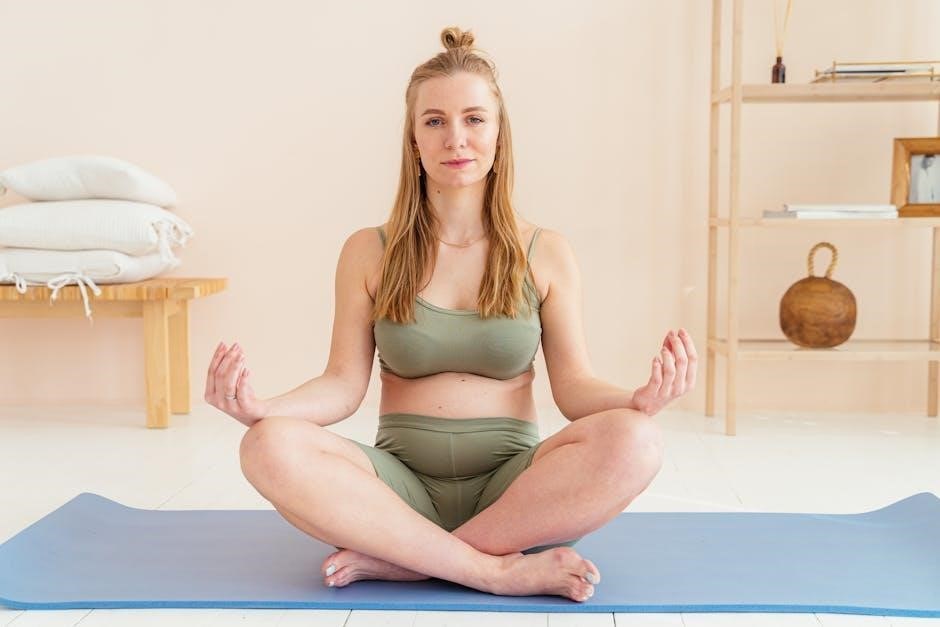
Importance of the 26 Bikram Yoga Poses
The 26 Bikram Yoga poses are carefully crafted to work every part of the body systematically. Each pose is designed to enhance strength‚ flexibility‚ and circulation while detoxifying the body through sweating. The sequence is intended to restore health‚ balance‚ and vitality by targeting specific muscles‚ organs‚ and systems. Regular practice of these poses can improve cardiovascular health‚ reduce stress‚ and boost metabolism. The structured approach ensures that each pose complements the others‚ creating a holistic workout. A downloadable PDF guide is available‚ detailing each pose and its benefits‚ making it an essential tool for both beginners and experienced practitioners to maximize their practice.
Benefits of Practicing Bikram Yoga
Practicing Bikram Yoga offers numerous physical and mental benefits. It improves circulation‚ strengthens muscles‚ and enhances flexibility. The heat promotes detoxification through sweating‚ while the structured poses target specific areas to boost metabolism and energy levels. Regular practice can aid in weight loss‚ improve cardiovascular health‚ and reduce chronic pain. Mentally‚ it reduces stress and anxiety‚ fostering mindfulness and focus. The discipline of the practice also enhances self-control and determination. Over time‚ practitioners often experience improved posture‚ better sleep quality‚ and a stronger immune system. A downloadable PDF guide can help you explore these benefits further and tailor your practice to achieve optimal results.

Origins and History of Bikram Yoga
Bikram Yoga‚ founded by Bikram Choudhury‚ originated from traditional Hatha Yoga. It involves 26 specific poses practiced in a heated environment‚ designed to promote physical and mental well-being. A PDF guide details its evolution and benefits.
Founder of Bikram Yoga: Bikram Choudhury
Bikram Choudhury‚ born in Kolkata‚ India‚ is the founder of Bikram Yoga. A renowned yoga practitioner and former weightlifter‚ he developed the 26-pose sequence after recovering from a severe injury. Choudhury’s method combines traditional Hatha Yoga with a modern‚ scientific approach‚ emphasizing heat to detoxify and stretch the body. He popularized his technique globally‚ establishing studios worldwide. His teachings stress the importance of proper alignment and breathing. A downloadable PDF guide details his innovative approach‚ making it accessible to practitioners. Despite facing controversies‚ Choudhury’s contributions to yoga remain significant‚ with his method continuing to inspire millions.
Evolution of the 26-Pose Sequence
The 26-pose sequence in Bikram Yoga was developed by Bikram Choudhury as a systematic approach to balance the body’s systems. Designed to be practiced in a heated environment‚ the sequence progresses from standing postures to floor postures‚ targeting every major muscle group. Choudhury crafted this method to address modern health challenges‚ combining traditional Hatha Yoga techniques with scientific insights. The sequence begins with warming up and breathing exercises‚ followed by postures that promote strength‚ flexibility‚ and cardiovascular health. Each pose builds on the previous one‚ ensuring a comprehensive workout. A downloadable PDF guide details the sequence‚ helping practitioners follow the method accurately. This structured approach has made Bikram Yoga a popular choice for those seeking holistic wellness.
Philosophy Behind the Bikram Method
The Bikram Method is rooted in the belief that heat promotes detoxification and healing. founder Bikram Choudhury designed the sequence to systematically work every part of the body‚ fostering physical and mental renewal. The method emphasizes consistency and repetition‚ ensuring each pose is held to maximize benefits. Practitioners are encouraged to embrace discomfort and focus on proper alignment. Heat is believed to mirror the human body’s natural temperature‚ aiding in flexibility and cleansing. This holistic approach aims to unite body‚ mind‚ and spirit through disciplined practice. A downloadable PDF guide outlines the philosophy and poses‚ helping students adhere to the method’s principles and achieve optimal results. This structured practice is taught uniformly worldwide‚ ensuring consistency and effectiveness for all practitioners.
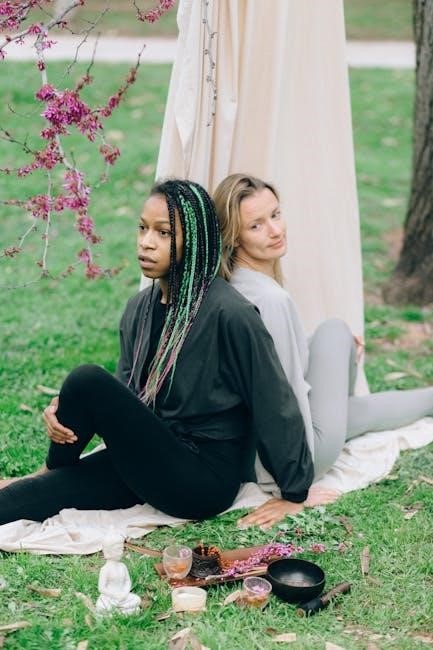
Structure of a Bikram Yoga Class
A Bikram Yoga class is a 90-minute session in a heated room‚ following a set sequence of 26 poses and two breathing exercises. The structured format ensures a comprehensive workout‚ targeting strength‚ flexibility‚ and detoxification. Heat plays a central role‚ promoting sweating and deep muscle engagement. Classes are led by certified instructors who guide students through the poses‚ emphasizing proper alignment and technique. A downloadable PDF guide is available for practitioners to reference the poses and breathing exercises‚ enhancing their practice and understanding of the method.
90-Minute Class Format
A Bikram Yoga class lasts exactly 90 minutes‚ conducted in a heated room with temperatures around 105°F and 40% humidity. The session begins with Standing Deep Breathing to prepare the body and mind. The sequence includes 26 poses and two breathing exercises‚ carefully designed to work every muscle‚ organ‚ and system. Each pose is held for a specific duration‚ allowing for maximum benefits. The heat promotes sweating‚ aiding in detoxification and flexibility. Instructors guide students through the poses‚ ensuring proper alignment and technique. The structured format ensures a comprehensive workout‚ balancing strength‚ flexibility‚ and mental focus. A PDF guide is available for reference‚ detailing the poses and breathing exercises for home practice.
Role of Heat in Bikram Yoga
Bikram Yoga is practiced in a heated room with temperatures around 105°F and 40% humidity. The heat mimics the climate of India‚ where yoga originated‚ and accelerates detoxification through sweating. It increases heart rate‚ making the workout more intense‚ and warms the muscles‚ enhancing flexibility and reducing injury risk. The heat also promotes mental focus and stamina. While challenging‚ the heat is a cornerstone of the practice‚ designed to purify the body and prepare it for the 26 poses. A PDF guide provides insights into how the heat complements the sequence‚ ensuring a holistic and transformative experience for practitioners.
Sequence of Poses and Breathing Exercises
The Bikram Yoga sequence includes 26 poses and two breathing exercises‚ carefully designed to work every part of the body. Each pose is held for a specific duration‚ allowing deep stretching and alignment. The sequence starts with Standing Deep Breathing to warm up and prepare the body. It progresses through standing postures‚ balancing poses‚ twists‚ and floor postures‚ ending with cooling down. Breathing techniques like Kapalabhati and Bhastrika are integrated to enhance oxygen flow and mental focus. A PDF guide details each pose and breathwork‚ ensuring proper form and maximum benefits‚ making it an essential resource for both beginners and advanced practitioners to follow the sequence effectively.
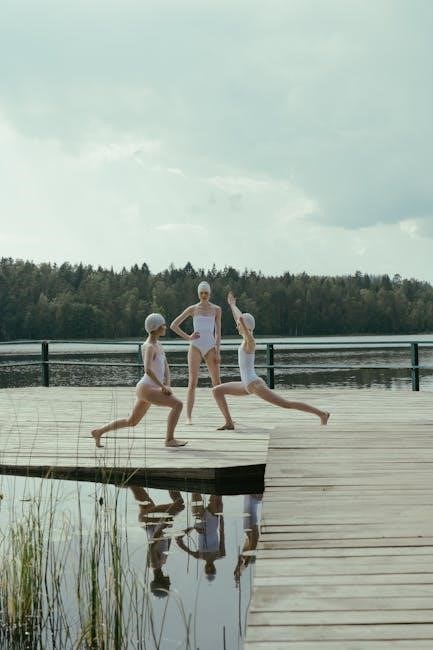
Standing Postures in Bikram Yoga
Bikram Yoga begins with standing postures to build foundation and balance. Poses like Eagle Pose and Standing Deep Breathing strengthen the body and prepare for deeper stretches. A PDF guide details proper alignment and execution for optimal benefits‚ ensuring each posture is performed safely and effectively to enhance overall well-being.
Standing Deep Breathing (Pranayama)
Standing Deep Breathing‚ or Pranayama‚ is the foundational pose of Bikram Yoga. It begins with feet hip-width apart‚ arms stretched overhead‚ and interlocked fingers. Inhale deeply‚ filling the lungs completely‚ then exhale slowly‚ releasing tension. This pose warms up the body‚ preparing it for subsequent postures. Proper breathing technique is emphasized to maximize oxygen flow and energize the body. A PDF guide provides visual cues and step-by-step instructions to ensure correct form and breathing. Regular practice enhances respiratory health and mental focus‚ setting the tone for a transformative yoga session.
Eagle Pose (Garurasana)
Eagle Pose‚ or Garurasana‚ is a standing posture that enhances balance‚ strength‚ and flexibility. To perform it‚ stand tall‚ bend the knees slightly‚ and wrap the right leg over the left‚ interlocking the thighs. Extend the arms forward‚ palms together‚ and gaze ahead. This pose stretches the shoulders‚ opens the chest‚ and improves focus. Hold for 30 seconds‚ then switch legs. A PDF guide provides detailed visuals and tips to ensure proper alignment and maximum benefits. Regular practice of Eagle Pose strengthens the lower body‚ improves circulation‚ and promotes mental clarity‚ making it a cornerstone of the Bikram Yoga sequence.
Standing Separate Leg Stretching (Dandayamana-Dhanurasana)
Standing Separate Leg Stretching‚ or Dandayamana-Dhanurasana‚ is a dynamic standing posture that strengthens the legs‚ hips‚ and lower back. It also stretches the chest and shoulders while improving circulation and mental focus. To perform this pose‚ stand upright‚ separate the legs hip-width apart‚ and reach one arm forward while bending the torso. The other arm extends backward‚ creating a bow-like shape. Hold for 30 seconds before switching sides. Proper alignment is crucial to avoid strain‚ and a PDF guide offers clear instructions and visuals to help master this posture effectively. Regular practice enhances flexibility‚ balance‚ and overall physical alignment.
Triangle Pose (Trikonasana)
Triangle Pose‚ or Trikonasana‚ is a foundational standing posture that combines strength‚ balance‚ and flexibility. It stretches the arms‚ shoulders‚ and torso while engaging the legs and hips. To practice‚ stand with feet apart‚ extend one arm overhead‚ and slide the other hand down the opposite leg. Keep the spine long and knees locked. This pose improves circulation‚ strengthens the lower back‚ and enhances mental clarity. Holding for 30 seconds on each side promotes balance and symmetry. A PDF guide provides detailed visuals and instructions to ensure proper alignment and maximize the benefits of this versatile pose. Regular practice fosters overall physical and mental well-being.
Side Angle Pose (Utthita Parshvakonasana)
Side Angle Pose‚ or Utthita Parshvakonasana‚ is a dynamic standing posture that strengthens and stretches the entire body. It targets the hips‚ spine‚ and arms while improving balance and focus. To perform‚ stand with feet wide apart‚ extend one arm overhead‚ and place the other hand on the opposite leg. Keep the chest open and knees locked. This pose enhances flexibility‚ tones the muscles‚ and promotes proper alignment. Holding for 30 seconds on each side helps build endurance and mental concentration. A PDF guide offers step-by-step instructions and visuals to help master this pose effectively‚ ensuring maximum benefits for both body and mind.
Extended Triangle Pose
Extended Triangle Pose‚ or Utthita Trikonasana‚ is a foundational standing posture that combines balance‚ strength‚ and flexibility. It involves extending one arm overhead and the other towards the ground while stretching the spine. This pose targets the hips‚ legs‚ and torso‚ improving alignment and posture. It also enhances cardiovascular health by increasing heart rate and circulation. Proper alignment is key to avoid strain‚ with knees locked and weight evenly distributed. Holding this pose for up to 30 seconds on each side helps build endurance and mental focus. A PDF guide provides detailed instructions and visuals to ensure correct form and maximize benefits for practitioners of all levels.
Twisting Triangle Pose
Twisting Triangle Pose‚ or Parivrtta Trikonasana‚ is a dynamic standing posture that combines stretching and twisting. It involves reaching one arm upward while twisting the torso and placing the other hand on the floor or shin. This pose targets the hips‚ spine‚ and shoulders‚ improving flexibility and balance. It also stimulates digestion and energizes the body by compressing and releasing internal organs. Proper alignment is crucial‚ with knees locked and weight evenly distributed. Holding this pose for up to 30 seconds on each side enhances cardiovascular health and mental focus. A PDF guide offers detailed instructions to help practitioners master this pose effectively and safely.
Separate Leg Head to Knee Pose (Dandayamana-Bibhaktapada-Janushirasana)
This pose involves standing upright with legs separated and knees locked. The torso is folded forward‚ bringing the head toward the knee of one leg while extending the arms. It stretches the hamstrings‚ calves‚ and spine‚ improving circulation and mental focus. Proper alignment ensures the spine remains elongated‚ maximizing the stretch and benefiting the nervous system. Holding the pose for 30 seconds on each side enhances balance and flexibility. A PDF guide provides step-by-step instructions and visual cues to help practitioners perform this pose safely and effectively‚ ensuring optimal benefits for the body and mind. Regular practice strengthens the entire lower body and improves posture.
Extended Tree Pose (Talasana)
Extended Tree Pose is a balancing posture that enhances focus and stability. Stand on one leg‚ with the other foot resting against the inner thigh. Engage the core‚ extend arms overhead‚ and gaze forward. This pose strengthens the legs‚ calves‚ and ankles while improving balance and concentration. It also stretches the shoulders and chest‚ promoting better posture. Hold for 30 seconds on each leg‚ breathing deeply. A PDF guide offers detailed instructions to ensure proper alignment and maximize benefits. Regular practice helps build mental clarity and physical equilibrium‚ making it a foundational pose in the Bikram Yoga sequence.
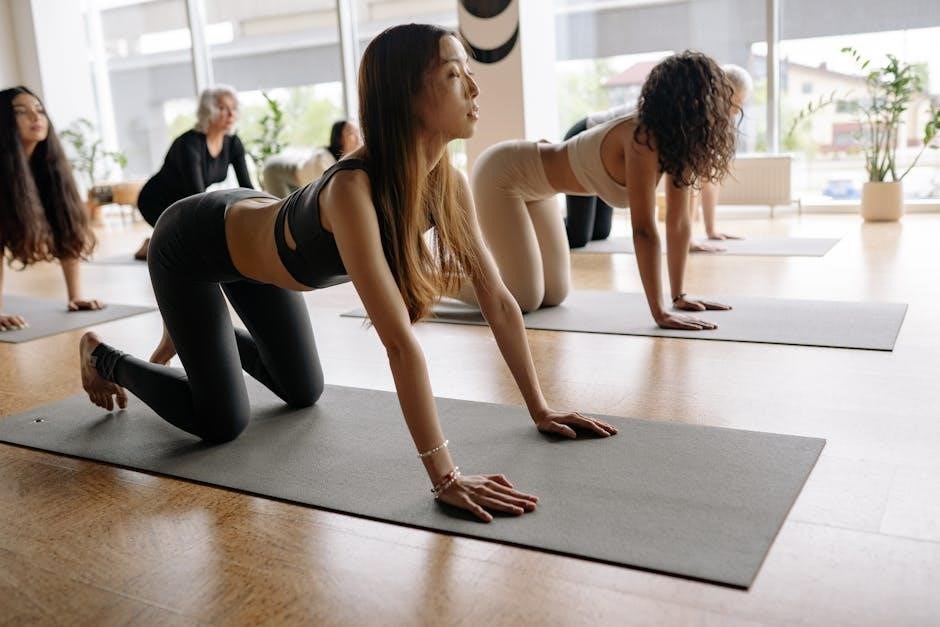
Balancing and Stretching Postures
Balancing and stretching postures in Bikram Yoga enhance flexibility‚ focus‚ and strength. These poses‚ like Toe Stand and Seated Forward Fold‚ improve alignment and reduce tension. A PDF guide provides detailed instructions for proper form and execution.
Toe Stand (Padangusthasana)
The Toe Stand‚ or Padangusthasana‚ is a foundational balancing pose in Bikram Yoga. It strengthens the ankles‚ calves‚ and feet while improving focus and stability. To perform‚ stand on the toes‚ keeping knees locked‚ and engage the core. Arms can be extended overhead or held in a prayer position for balance. This pose enhances posture and prepares the body for more complex standing postures. Proper alignment is crucial to avoid strain. A PDF guide provides visual cues and step-by-step instructions to master this pose effectively. Regular practice improves overall balance and coordination in daily activities.
Staff Pose (Dandasana)
Staff Pose‚ or Dandasana‚ is a foundational seated posture in Bikram Yoga. It strengthens the spine‚ improves posture‚ and prepares the body for forward bends. Sit with legs extended‚ feet flexed‚ and hands beside the hips. Engage the core‚ lift the chest‚ and maintain a straight spine. This pose promotes good alignment‚ balance‚ and focus. It is essential for building strength and flexibility in the lower back and hips. A PDF guide provides detailed instructions and visuals to ensure proper form. Regular practice enhances overall spinal health and sets the foundation for more advanced seated postures in the sequence.
Seated Forward Fold (Paschimottanasana)
Seated Forward Fold‚ or Paschimottanasana‚ is a seated posture that stretches the hamstrings‚ calves‚ and spine. Sit with legs extended‚ feet flexed‚ and hands by the hips. Inhale deeply‚ then exhale while folding forward‚ reaching for the toes or shins. Keep the back straight and engage the core to maintain balance. This pose improves flexibility‚ relieves tension‚ and enhances circulation. It is a key component of the Bikram Yoga sequence‚ promoting deep stretching and relaxation. A PDF guide offers step-by-step instructions and visuals to ensure proper alignment and maximum benefits from this pose.
Half Hero Pose ( Ardha Hanumanasana)
Half Hero Pose (Ardha Hanumanasana)
Half Hero Pose‚ or Ardha Hanumanasana‚ is a seated stretching posture that targets the hamstrings‚ quads‚ and hip flexors. Begin by sitting on the floor with one leg extended and the other bent behind you. Inhale‚ then exhale while leaning forward‚ reaching for the outstretched foot. Keep the back straight and engage the core for stability. This pose improves flexibility‚ strengthens the legs‚ and enhances circulation. It is a dynamic stretch that prepares the body for deeper postures. A PDF guide provides detailed instructions and visual aids to help master the proper alignment and technique for this pose.
Seated Separate Leg Stretching (Akarna Dhanurasana)
Seated Separate Leg Stretching‚ or Akarna Dhanurasana‚ is a seated posture that deeply stretches the hamstrings‚ hips‚ and spine. Sit on the floor with legs extended apart. Inhale deeply‚ then exhale while bending forward‚ reaching toward the toes. Keep the spine long‚ shoulders relaxed‚ and head in a neutral position. This pose improves flexibility‚ relieves tension in the lower back‚ and enhances circulation. Proper alignment is crucial to avoid rounding the back. A PDF guide provides step-by-step instructions and visuals to ensure correct form and maximize the benefits of this pose in Bikram Yoga practice.

Twisting and Inversion Postures
Twisting and inversion postures in Bikram Yoga enhance flexibility‚ balance‚ and mental focus. Key poses include Rabbit‚ Head-to-Knee‚ and Seated Forward Fold. A PDF guide provides detailed insights.
Sasangasana (Rabbit Pose)
Sasangasana‚ or Rabbit Pose‚ is a twisting and inverting posture that deeply stretches the spine‚ hips‚ and shoulders. To perform it‚ sit on your heels‚ bend forward‚ and grab your heels with your hands. Inhale and lift your hips while tucking your chin to your chest‚ creating a gentle twist. This pose improves circulation‚ relieves tension‚ and strengthens the neck and torso. It also enhances mental focus and balance. Proper alignment is key to avoid strain. A Bikram Yoga PDF guide provides detailed instructions and visuals for mastering this pose effectively. Regular practice can lead to improved flexibility and overall well-being.
Janushirasana (Head to Knee Pose)
Janushirasana‚ or Head to Knee Pose‚ is a seated forward bend that stretches the hamstrings‚ spine‚ and hips. Sit on your heels‚ extend your arms‚ and fold forward‚ bringing your forehead to your knees. This pose improves flexibility‚ balances the nervous system‚ and enhances circulation. It is particularly effective for relieving stress and tension in the lower back. A Bikram Yoga PDF guide provides step-by-step instructions and images to ensure proper alignment and maximize benefits. Regular practice of Janushirasana can lead to greater mobility and a deeper connection between body and mind‚ making it a foundational pose in the Bikram sequence.
Paschimottanasana (Seated Forward Fold)
Paschimottanasana‚ or Seated Forward Fold‚ is a powerful stretch that targets the hamstrings‚ spine‚ and hips. Sit with extended legs‚ inhale to lengthen your spine‚ then exhale to fold forward‚ reaching for your toes or shins. This pose enhances flexibility‚ improves circulation‚ and calms the nervous system; It is particularly beneficial for relieving lower back tension and promoting relaxation. A Bikram Yoga PDF guide provides detailed instructions to ensure proper alignment and breathing techniques‚ helping practitioners deepen their practice safely and effectively. Regular practice of Paschimottanasana can lead to increased flexibility and overall well-being‚ making it a cornerstone of the Bikram sequence.
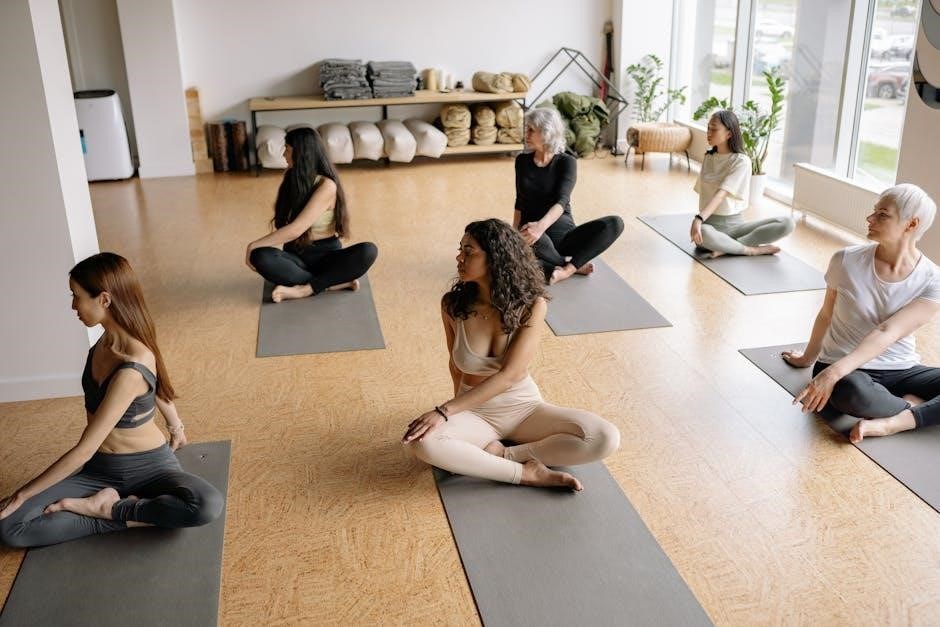
Backbends and Strengthening Postures
Backbends and strengthening postures in Bikram Yoga‚ like Cobra‚ Locust‚ and Full Locust poses‚ target the spine and core‚ enhancing strength and flexibility. A Bikram Yoga PDF guide details these poses‚ promoting improved posture and overall vitality through consistent practice.
Cobra Pose (Bhujangasana)
Cobra Pose‚ or Bhujangasana‚ is a foundational backbend in Bikram Yoga that strengthens the back muscles and improves spinal flexibility. Practiced in the heated environment‚ it helps detoxify the body through sweating. To perform‚ lie on your stomach with hands under your shoulders‚ inhale deeply‚ and press your palms into the floor to lift your chest and head off the ground. Keep your shoulders down and away from your ears‚ engaging your core for stability. This pose strengthens the arms and shoulders while enhancing posture and reducing back pain; Regular practice in Bikram Yoga classes can improve cardiovascular health and overall vitality. A Bikram Yoga PDF guide provides detailed alignment tips for mastering Bhujangasana effectively.
Locust Pose (Salabhasana)
Locust Pose‚ or Salabhasana‚ is a strengthening posture in Bikram Yoga that targets the back muscles‚ arms‚ and legs. Practiced in the heated environment‚ it enhances stamina and endurance. To perform‚ lie on your stomach with arms extended overhead‚ then lift your chest‚ arms‚ and legs simultaneously while engaging your lower back muscles. This pose improves posture‚ balances the nervous system‚ and strengthens the shoulders and hips. The heat amplifies its detoxifying effects‚ promoting sweat and cleansing the body. Regular practice in Bikram Yoga classes can enhance overall physical strength and mental focus. A detailed guide in the Bikram Yoga PDF provides proper alignment techniques for Salabhasana.
Full Locust Pose (Poorna Salabhasana)
Full Locust Pose‚ or Poorna Salabhasana‚ is an advanced strengthening posture in Bikram Yoga that builds significant back‚ arm‚ and leg strength. Practiced in the heated environment‚ it enhances stamina and endurance. To perform‚ lie on your stomach with arms extended overhead‚ then lift your chest‚ arms‚ and legs simultaneously while engaging your lower back muscles. This pose improves posture‚ balances the nervous system‚ and strengthens the shoulders and hips. The heat amplifies its detoxifying effects‚ promoting sweat and cleansing the body. Regular practice in Bikram Yoga classes can enhance overall physical strength and mental focus. A detailed guide in the Bikram Yoga PDF provides proper alignment techniques for Poorna Salabhasana.
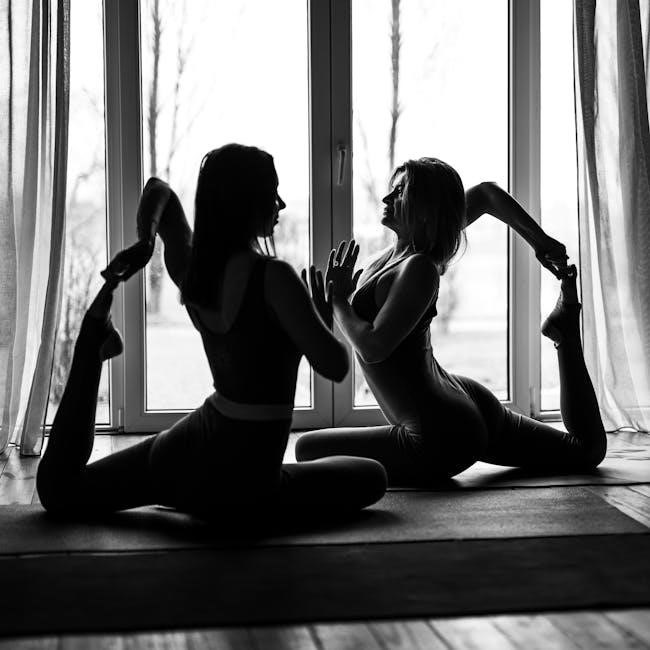
Breathing Techniques in Bikram Yoga
Breathing Techniques in Bikram Yoga involve Kapalabhati and Bhastrika‚ enhancing detoxification and energy. These practices‚ detailed in the Bikram Yoga PDF‚ are essential for optimizing poses and overall well-being.
Kapalabhati Breathing
Kapalabhati Breathing‚ or “Breath of Fire‚” is a powerful cleansing technique in Bikram Yoga. It involves rapid‚ shallow exhales through the nose‚ with the abdomen pumping inward. This breath is performed passively‚ allowing the diaphragm to drop and the lungs to empty naturally. Kapalabhati helps detoxify the body by stimulating the abdominal organs and promoting the expulsion of stale air from the lungs. It is often practiced during transitions between poses to refresh the body and mind. The Bikram Yoga PDF guide provides clear instructions on mastering this essential breathing technique‚ ensuring proper form and maximum benefits during practice.
Bhastrika Breathing
Bhastrika Breathing‚ or “Bellows Breath‚” is a dynamic yoga breathing technique that mimics the action of a blacksmith’s bellows. It involves rapid‚ forceful inhalations and exhalations through the nose‚ keeping the mouth closed. This breath is energizing and helps purify the nervous system by increasing oxygen flow. In Bikram Yoga‚ Bhastrika is often practiced during transitions to prepare the body for intense postures. The Bikram Yoga PDF guide details how to perform this breath correctly‚ emphasizing proper timing and rhythm to avoid strain. Mastery of Bhastrika enhances endurance and mental focus‚ making it a vital component of the practice.
Bikram Yoga offers transformative benefits‚ enhancing strength‚ flexibility‚ and mental clarity. For practitioners seeking guidance‚ a downloadable PDF guide provides detailed pose instructions and sequences‚ ensuring mastery and safety in practice.
Final Thoughts on Bikram Yoga
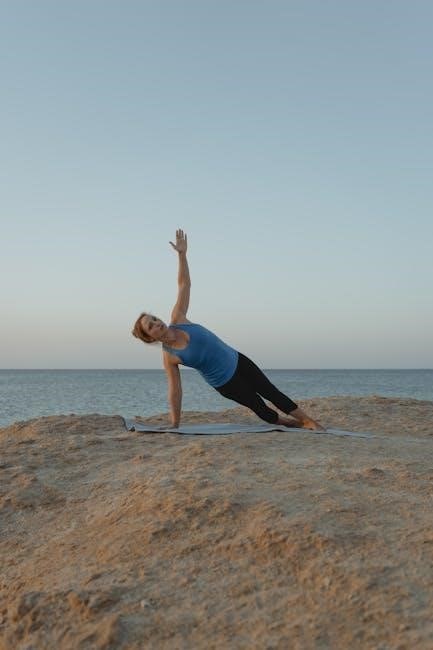
Bikram Yoga is a transformative practice that combines physical postures‚ breathing techniques‚ and heat to create a holistic workout. The 26 poses‚ practiced in sequence‚ are designed to challenge the body‚ improve circulation‚ and promote detoxification through sweating. Regular practice can enhance strength‚ flexibility‚ and mental clarity while fostering discipline and focus. For those new to Bikram Yoga‚ starting with the foundational poses like Standing Deep Breathing and Eagle Pose can build confidence and prepare the body for more complex postures. The structured approach of Bikram Yoga ensures a comprehensive workout‚ making it accessible to all levels. Embrace the heat and unlock its full potential!
Downloadable PDF Guide for Bikram Yoga Poses
A downloadable PDF guide for Bikram Yoga poses provides a comprehensive overview of the 26 postures‚ making it easy to follow and practice. This guide includes detailed descriptions‚ images‚ and tips for mastering each pose‚ ensuring proper alignment and technique. It categorizes the postures into standing‚ balancing‚ twisting‚ and backbending sequences‚ along with breathing exercises like Kapalabhati and Bhastrika. Perfect for both beginners and advanced practitioners‚ the PDF serves as a convenient reference to deepen your understanding of Bikram Yoga. Its portability allows you to practice anywhere‚ making it an essential resource for anyone looking to refine their practice and enjoy the full benefits of this transformative yoga style.
